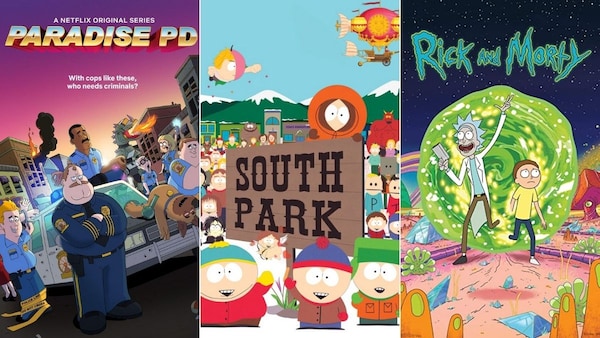Are adult animation series the unabashed naysayers to privilege? Examining Rick & Morty, South Park, Paradise PD under this lens
After Chicago Party Aunt’s release on Netflix, here’s a low-down on how adult animation has shaped mainstream narratives and included the marginalised into it

Last Updated: 05.28 PM, Sep 20, 2021
In a world with gradually constricting borders, and its people becoming more and more divisive by the day, social justice warriors are always up in arms against what they consider “inappropriate”. Cinema has always punched up to such privilege, but it’s interesting to note how the animation space has also risen to the occasion and been an unabashed naysayer to fundamentalist global regimes and practices. These cartoons are pushing the narrative to alter the general perspective (both about the world, and on what a ‘cartoon’ should or should not include).
These shows have made a purposeful attempt to include marginalised, disenfranchised sections of society into their main plotlines in order to normalise their presence – from queer characters, transgenders, to ostracized women, these shows have proudly placed them front and centre of all attention. But this noteworthy shift has been a recent evolution. From the primitive, (in more ways than one) days of The Flintstones and reductive cartoons like Tom and Jerry, the present slate of adult animation includes promising series like Netflix’s Big Mouth (a show that charts the journey of young adults through their years of puberty), or even an Adventure Time and Steven Universe (they place same-sex couples thriving in an environment that has normalized this association).
If we were to revisit the history of animation on screen, The Flintstones on ABC was the first series to be aired as regular episodes way back in 1960. While the manner was mild and ‘funny’ per se, the episodes gave a microcosm of a familial unit, with its spate of issues – forgetting anniversary dates, getting the wrong rings, in-law problems and the entire shebang. On a similar strain, The Simpsons, which premiered almost three decades later, took up the American family as its crux – lacing the narrative with more biting tropes like the lazy, doofus dad, the adventurous-but-frustrated siblings, and the sensible epicentre in the mother (always forgiving, always indulgent, yet the brains behind the running machinery).
But The Simpsons also brought to the fore a method in which animation was talking about socio-political issues of the time and how they could be seamlessly stitched into the bizzarro of their worlds.
What The Simpsons brought to the table as a conversation starter, South Park (1997) transformed into an eight-course meal. Matt Stone and Trey Park’s incisive Comedy Central series charts the exploits of four foul-mouthed children residing in Colorado. The crudeness of their humour was an uncomfortable shift that was both unexpected and a welcome change. The satire incessantly took up social issues and delved into it further, always on the nose, voicing the true opinions of the audience at large.
Their audacious nature even made them a subject of mass social ire, with various groups attacking the makers (for example: when the Christian Family Network called the series “vile trash.”) South Park was unafraid of being the hated kid on the block who always spewed truth bombs. The show, initially thought to hardly attract the mass audience, did achieve cult status, and was recognized as one platform through which off-centre narratives were finding a voice.
In the same year, Seth MacFarlane’s Family Guy introduced a similar concept on-screen, forming the perfect blend of South Park’s sarcasm and The Simpsons’ simplicity. Though MacFarlane may not be the most sophisticated of makers in the circuit (a much-discussed and critiqued aspect), his works were subject to mass consumerism. Peter Griffin’s family was a heady concoction of wry, inappropriate characters that were all oddities in their own way. While the series came under grave criticism (during the Black Lives Matter furore) for its white voice actor Mike Henry, who voiced the role of the Black character Cleveland.
Rick Sanchez’s 2013 eccentric science-fiction adventure series Rick and Morty began with a silly parody of Back to the Future. Creators Justin Roiland and Dan Hartman gradually created a brand that was an acquired taste, that needed sections of audiences to be accustomed to the wacky zaniness of the brilliantly built alternate world, a world that was constructed with sci-fi concepts of and occasional deep-dives into characters.
Matt Groening’s Futurama (1999) used a similar premise and told stories that needed the imagination racing to creative zones that would have been difficult to achieve through normal real-life sequences.
From more recent examples, 2018’s Paradise PD brought forth the perfect amalgamation of profanity, gratuitous violence and casual nudity. Netflix’s OTT format allowed for the series to spread its imagination and achieve what would have been otherwise impossible from a television perspective. Waco O'Guin and Roger Black’s Brickleberry-esque series brought forth the adventures of small-town cops. Very similar to Family Guy with respect to its gross-out humour and pop culture references, Paradise PD was all about the scatalogical humour.
Animation has always made space for alternate storytelling. Especially with the OTT platforms providing an alternate platform for their depictions, it becomes even easier for creators to come up with unconventional plotlines and brave narratives that permit the audience spectrum to also widen.

 Premium
Premium